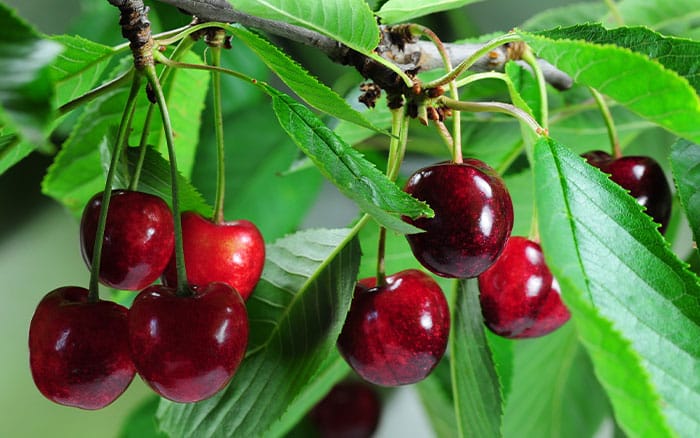Cherries are delicious, and a popular fruit enjoyed throughout the world. Whether you prefer them fresh, or enjoy cooking them into a pie of crumble, there is a variety of cherry tree that you could grow in your garden.
Cultivating Cherries
The ideal time of year to get your cherry trees planted is between November and March. This time is best because the tree is dormant, so doesn’t need to use much energy.
Bare-root trees are only available between November and March. However, potted trees are available year-round, and could potentially be planted anytime, though November to March are best.
Cherry trees are easy to find a location for and aren’t too fussy. They’re ideal for an open site like a lawn or can be trained to grow up a wall or fence. You can also grow semi-dwarf varieties in containers. Try to choose a container that is at least 45-50cm wide.

All cherry trees prefer fertile, well-drained soil that is slightly on the acidic side of the pH scale. Try to aim for a pH of 6.5-6.7 if you can.
These trees prefer a warm, sheltered spot. They don’t tend to cope very well against frost, so somewhere they would be best protected against this is ideal. A sunny spot would be perfect, but Morello cherries can tolerate some shade if you have a darker garden.
A few varieties of cherry trees have received the RHS Award of Garden Merit, including Prunus ‘Sweetheart’. This produces a dark and sweet cherry that crops through summer until September. Another award-winning cherry tree to consider growing is Prunus ‘Morello’, which grows acidic cherries, and self-fertilises. It has wonderful blossoms before producing fruit between July and August. These tarter cherries are often used to cook and bake with!
Fun Fact
Commercial cherry tree growers have mastered harvesting the fruit to a fine art. In fact, one whole cherry tree can be harvested within 7 seconds, thanks to mechanical harvesters. However, because of the intensity of the machine, it shortens a cherry tree’s life by several years.
Take care

Cherry trees are particularly vulnerable to cherry blackflies, and fruit flies. You can tell whether this has happened because the maggots of these flies invade the cherries and cause rotting. It may also be worth netting your trees if your garden is frequently visited by birds, as they enjoy munching on these sweet fruits.
At the start of the growing season, make sure to give your cherry trees a lot of attention, as they are quite early flowerers.
You can do this by mulching the roots with well-rotted manure in February, and general fertiliser throughout March.
These trees are ideal for fan training against a wall or a fence, which is a popular option. This is perfect for saving space and making an attractive feature. However, cherry trees are too vigorous for training into espaliers or cordons, so best to avoid trying this at home.
Pruning should be carried out annually to keep them compact, making the fruit easier to harvest. This will also guarantee that you have a good balance of older fruiting wood and younger branches.
Fun Fact
We may have been eating cherries for a very long time. Thousands of years, in fact. In Europe and Asia, fossilised cherry pits have been found in prehistoric caves by archaeologists. This means humans have probably enjoyed cherries since the stone age! And we have probably been cultivating their trees since the Romans did in 72 BC.
Collect your Cherries
The fruit of your cherry trees should be ready for harvesting in the early summer, depending on which variety you are growing.
You can know that your fruit is ready when they are fully coloured, and firm. Try to pick a dry day to harvest your fruit if possible.
You harvest them by cutting them from the tree, with their stalks attached and intact. By cutting them off with the stalks still attached, you have a better chance of not bruising the fruit.

Make sure to store your cherries in the fridge if you don’t plan on eating them immediately. Sweet cherries are better eaten fresh, but you can store them in a sealed plastic bag or container for up to a week. If you have acidic cherries, they are too tart to eat raw, but they are ideal for cooking into preserves or delicious baked goods. Just ensure to be mindful of the stone in the middle before eating.
These lovely fruits not only taste amazing, but they pack a punch with health benefits too. They are full of antioxidants, which you can identify thanks to their red colour, which is caused by anthocyanins. Anthocyanins not only have antioxidant properties, but there is evidence to suggest they may have a role in preventing certain diseases. As well as this, they also have a great vitamin content.

Leave A Comment